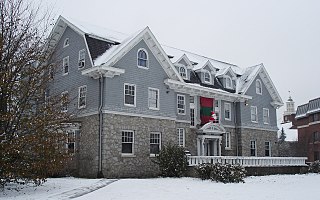
North American fraternity and sorority housing refers largely to the houses or housing areas in which fraternity and sorority members live and work together. In addition to serving as housing, fraternity and sorority housing may also serve to host social gatherings, meetings, and functions that benefit the community.
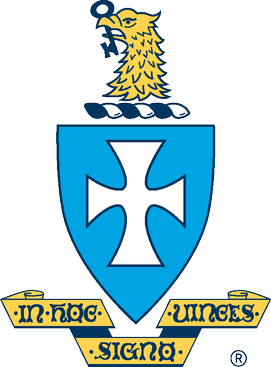
Sigma Chi (ΣΧ) International Fraternity is one of the largest of North American social fraternities. The fraternity has 244 active undergraduate chapters and 152 alumni chapters across the United States and Canada and has initiated over 350,000 members. The fraternity was founded on June 28, 1855, at Miami University in Oxford, Ohio, by members who split from the Delta Kappa Epsilon fraternity.

The University of Tennessee at Chattanooga is a public university in Chattanooga, Tennessee, United States. It was founded in 1886 and is part of the University of Tennessee System.

The Chattanooga Area Regional Transportation Authority (CARTA) is the mass transit provider for Chattanooga, Tennessee and its vicinity.
While the traditional social fraternity is a well-established mainstay across the United States at institutions of higher learning, alternatives – in the form of social fraternities that require doctrinal and behavioral conformity to the Christian faith – developed in the early 20th century. They continue to grow in size and popularity.
A student quarter or a student ghetto is a residential area, usually in proximity to a college or university, that houses mostly students. Due to the youth and relative low income of the students, most of the housing is rented, with some cooperatives. Landlords have little incentive to properly maintain the housing stock, since they know that they can always find tenants. Non-students tend to leave the area because of the noise and raucous behavior of the students. Property crimes, sexual assaults, and noise and drug violations are more common in student quarters.

Sigma Gamma Chi (ΣΓΧ) was a fraternal organization sponsored by the Church of Jesus Christ of Latter-day Saints. Although it once was a national organization, it later only operated at the University of Utah.
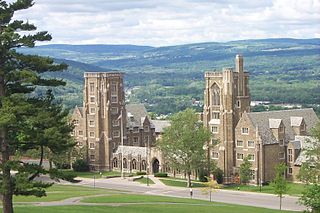
West Campus is a residential section of Cornell University's Ithaca, New York campus. As defined by the 2008 Master Plan, it is bounded roughly by Fall Creek gorge to the north, West Avenue and Libe Slope to the east, Cascadilla gorge and the Ithaca City Cemetery to the south, and University Avenue and Lake Street to the west. It now primarily houses transfer students, second year students, and upperclassmen.

Sigma Phi Epsilon (ΣΦΕ), commonly known as SigEp, is a social college fraternity for male college students in the United States. It was founded on November 1, 1901, at Richmond College, which is now the University of Richmond, and its national headquarters remains in Richmond, Virginia. It was founded on three principles: Virtue, Diligence, and Brotherly Love. Sigma Phi Epsilon is one of the largest social fraternities in the United States in terms of current undergraduate membership.

The upper campus residence halls at the University of Pittsburgh include Sutherland Hall, Panther Hall, K. Leroy Irvis Hall, the fraternity housing complex, and the Darragh Street Apartments. Among the newest residence facilities at the university, these buildings reside on the upper campus located near many of the school's athletic facilities. The upper campus resides approximately 200 feet (61 m) above the lower campus that lies along Forbes and Fifth Avenues, providing dramatic views along the hilltop and slopes. Planning for upper campus student housing originated in the late 1960s and early 1970s, but stalled due to community and political opposition until the early 1990s with opening of Sutherland Hall, the first major student residence constructed by Pitt in 29 years.
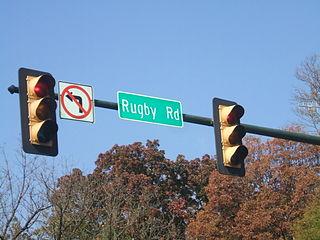
Rugby Road is a street in Charlottesville, Virginia that serves as the center of the University of Virginia's fraternity and sorority system and its attendant social activity. It is located across the street from central Grounds, beginning at University Avenue across the street from the Rotunda branching off at Preston Avenue and finally curving down to the 250 Bypass, and marks one end of The Corner, a strip of restaurants and stores that cater mainly to students. Rugby Road is lined with a variety of architecturally significant houses from several different decades. Many of these are currently used by fraternities and sororities, although the majority of them were originally intended for single-family use; William Faulkner was one famous resident while he was a writer in residence at the University.
West Campus is a neighborhood in central Austin, Texas west of Guadalupe Street and its namesake, the University of Texas at Austin. Due to its proximity to the university, West Campus is heavily populated by college students.

Delta Sigma Chi (ΔΣΧ) is an American fraternal organization for professionals in the area of Chiropractic.
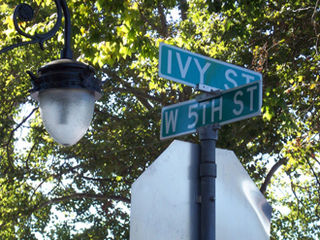
The South Campus Historic District is a historic district in Chico, California which was named to the National Register of Historic Places in 1991 through efforts of the Chico Heritage Association. The district is situated entirely within the South Campus Neighborhood. The historical district extends from Salem Street to Cherry Street, and from West Second Street to West Sixth Street. Whereas, the neighborhood extends from West Second Street south to West Ninth Street and west from Salem Street all the way to the city limits, which, in that area, is called the "Green Line." The South Campus Neighborhood Association represents the interests of the neighborhood to the community. There are several fraternity and sorority houses in the area, and the city has designated the South Campus Fraternity/Sorority Overlay Zone which is largely contiguous with the neighborhood and district.

Frank M. Riley was an architect of Madison, Wisconsin. A number of his works are listed on the National Register of Historic Places for their architecture.

Parish Apartments, also known as the Sigma Pi Fraternity House and the St. Thomas More Parish Center, is a historic building located in Iowa City, Iowa, United States. It was listed on the National Register of Historic Places in 2013 as the Sigma Pi Fraternity House.

















